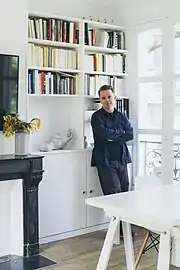Grégory Chatonsky
Grégory Chatonsky (May 4, 1971) is a French and Canadian Artist who works with interactive installations, networked devices, photographs and sculptures. He explores the relationship between technologies and affectivity creating new forms of fiction.
Grégory Chatonsky | |
|---|---|
 Grégory Chatonsky | |
| Born | May 4, 1971 Paris (France) |
| Nationality | French and Canadian |
| Occupation | Artist and writer |
| Movement | Internet art Netart Postdigital Photography Installation art |
Early life and education
After completing studies in Visual Arts and Philosophy at La Sorbonne Pantheon-Sorbonne University, Grégory Chatonsky began his master's degree at the ENSBA and at ENST finishing in 1999. In March 2016 he was awarded his PhD from Université du Québec à Montréal for his dissertation: Aesthetics of flows (after digital).[1]
Work
Grégory Chatonsky is one of the early practitioners of Internet art having founded in 1994 incident.net, an Internet art collective exploring the notions of the accidental, the glitch and unpredictability. During this early period of internet he created the website of Centre Georges Pompidou. From 1994 to 1997, Chatonsky, researched, wrote the screenplay and produced the CD-ROM, Mémoires de la Déportation, about deportations and the Holocaust in France.[2] From the mid-nineties Chatonsky produced films, audios and code-based work for the internet, including Counter (1995), a website that existed solely to count visitors, 2fresh (1997), a snippit of HTML script, and La Vitesse du Silence (1999), a netart performance piece.
Produced at the C³ Center for Culture & Communication Foundation (with Reynald Drouhin) and at Biennale d’art contemporain de Montréal, Revenances (1999) was an online performance work that invited the viewer to slow down their browsing and consider glitches and pauses as spaces where "ghosts" may interact.[3]
Chatonsky divides his time between France and Canada. He has taught at Le Fresnoy-Studio national des arts contemporains, France, at Université du Québec à Montréal’s School of visual and media art and he is artist-researcher at École Normale Supérieure in Paris on artificial imagination.
Bibliography
Boutet de Monvel, Violaine (2008) "La destruction comme point de départ à une sémiotique libérée". Paris Art.
Couchot, Edmond (2007) Des images du temps et des machines dans les arts et la communication. Éditions Jacqueline Chambon-Actes Sud. Paris
Doyon, Frédérique (11 October 2007) "Le septième art de demain" Le Devoir, Montréal.
Fan, Ruan (28 April 2015) "French artist explores future archeology". China Daily. Beijing
Lechner, Marie (15 April 2014) "Entretien croisé entre l’artiste Grégory Chatonsky, concepteur de Capture, et le musicologue Peter Szendy". Libération. Paris
Miguirditchian, Julie (2010) "Artist in the flow". Digitalarti Mag
Mufson, Beckett (15 May 2015) "Here Are Imaginary Fossils from a Post-Human Earth". The Creators Project
Murphy, Jay (2009) "A fiction without narration", thing.net
Palmiéri, Christine (2013) "Fossilisation du futur", Archée
Popper, Frank (2006) From Technological to Virtual Art. MIT Press. Boston
Thome de Souza, Kevin (25 March 2014) "Grégory Chatonsky’s Capture: generative art pushed to its limits". Amusement
References
- "Esthétique des flux, après le digital" (PDF). UQAM, Canada. 22 June 2018. Retrieved 20 October 2019.
- "Interview with Grégory Chatonsky". scart, Belgium. 22 June 2012. Retrieved 20 November 2016.
- Saemmer, Alexandra (February 5, 2010) "Digital literature. A question of style", in Reading Moving Letters: Digital Literature in Research and Teaching, A Handbook, ed. R. Simanowski, J. Schäfer, et P. Gendolla. Transcript-Verlag, Bielefeld. Germany